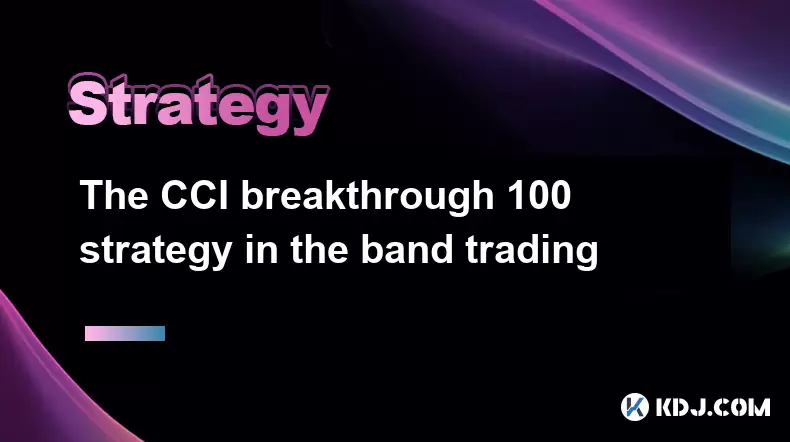-
 bitcoin
bitcoin $122288.232522 USD
0.16% -
 ethereum
ethereum $4480.662914 USD
-0.22% -
 xrp
xrp $2.962747 USD
-2.32% -
 tether
tether $1.000120 USD
-0.05% -
 bnb
bnb $1145.654223 USD
-2.07% -
 solana
solana $227.105217 USD
-1.67% -
 usd-coin
usd-coin $0.999548 USD
-0.02% -
 dogecoin
dogecoin $0.250875 USD
-2.04% -
 tron
tron $0.340654 USD
-0.49% -
 cardano
cardano $0.837968 USD
-2.52% -
 hyperliquid
hyperliquid $48.960449 USD
0.06% -
 chainlink
chainlink $22.049280 USD
-1.33% -
 ethena-usde
ethena-usde $1.000404 USD
0.02% -
 sui
sui $3.586212 USD
0.20% -
 avalanche
avalanche $29.894916 USD
-4.18%
The CCI breakthrough 100 strategy in the band trading
The CCI breakthrough 100 strategy uses the CCI crossing above +100 to signal strong bullish momentum, enhanced by band trading for better trade confirmation.
Jun 10, 2025 at 01:49 pm

The CCI (Commodity Channel Index) is a versatile technical indicator used by traders to identify potential entry and exit points in the market. When combined with band trading, the CCI breakthrough 100 strategy can offer traders a systematic approach to capitalize on market trends. This strategy revolves around the concept that when the CCI crosses above the level of 100, it indicates a strong bullish momentum, which can be used to initiate long positions within a band trading framework.
Understanding the CCI Indicator
The Commodity Channel Index (CCI) is a momentum-based oscillator used to determine when an asset is overbought or oversold. Developed by Donald Lambert, the CCI measures the current price level relative to an average price level over a given period of time. The formula for CCI is:
[ \text{CCI} = \frac{\text{Typical Price} - \text{SMA of Typical Price}}{\text{Constant} \times \text{Mean Deviation}} ]
Where:
- Typical Price is the average of the high, low, and close prices.
- SMA of Typical Price is the Simple Moving Average of the Typical Price.
- Constant is typically set to 0.015.
- Mean Deviation is the mean absolute deviation of the Typical Price from its SMA.
The CCI oscillates around a zero line, with readings above +100 indicating overbought conditions and readings below -100 indicating oversold conditions. For the CCI breakthrough 100 strategy, the focus is on the moment when the CCI crosses above the +100 level.
The Basics of Band Trading
Band trading involves using bands or envelopes around a moving average to define trading ranges. The most common type of band used in trading is the Bollinger Bands, which consist of a middle band (typically a 20-period moving average) and two outer bands that are standard deviations away from the middle band. Band trading strategies can help traders identify periods of high and low volatility and potential reversal points.
In the context of the CCI breakthrough 100 strategy, band trading serves as a framework to confirm the signals provided by the CCI. By integrating the CCI with band trading, traders can filter out false signals and enhance the probability of successful trades.
Implementing the CCI Breakthrough 100 Strategy
To implement the CCI breakthrough 100 strategy within a band trading framework, follow these steps:
- Set up the CCI Indicator: Add the CCI indicator to your trading chart with the standard settings (typically a 20-period CCI).
- Set up Bollinger Bands: Add Bollinger Bands to your chart with the standard settings (20-period SMA, 2 standard deviations).
- Monitor the CCI for Breakthroughs: Watch for the CCI to cross above the +100 level. This indicates strong bullish momentum.
- Confirm with Band Trading: Once the CCI crosses above +100, check the position of the price relative to the Bollinger Bands. If the price is above the lower band and moving towards the upper band, it confirms the bullish signal.
- Enter the Trade: Initiate a long position when both the CCI and band trading conditions are met.
- Set Stop-Loss and Take-Profit Levels: Place a stop-loss order below the lower Bollinger Band to manage risk. Set a take-profit order near the upper Bollinger Band to lock in profits.
Managing Risk in the CCI Breakthrough 100 Strategy
Effective risk management is crucial when employing the CCI breakthrough 100 strategy. Here are some key considerations:
- Position Sizing: Determine the size of your position based on your overall risk tolerance and the volatility of the asset you are trading.
- Stop-Loss Orders: Always use stop-loss orders to limit potential losses. Place the stop-loss order below the lower Bollinger Band to protect against adverse price movements.
- Take-Profit Orders: Set take-profit orders near the upper Bollinger Band to secure profits when the price reaches overbought levels.
- Diversification: Avoid putting all your capital into a single trade. Diversify your portfolio to spread risk across different assets and strategies.
Backtesting the CCI Breakthrough 100 Strategy
Backtesting is an essential step in validating the effectiveness of any trading strategy, including the CCI breakthrough 100 strategy. By simulating trades on historical data, you can assess the strategy's performance and make necessary adjustments.
- Select a Time Frame: Choose a relevant time frame for backtesting, such as daily or hourly charts, depending on your trading style.
- Historical Data: Gather historical price data for the asset you wish to trade.
- Execute the Strategy: Apply the CCI breakthrough 100 strategy to the historical data, following the steps outlined earlier.
- Evaluate Performance: Analyze the results, including the win rate, average profit per trade, and drawdown. Adjust the strategy parameters if necessary to optimize performance.
Real-World Application of the CCI Breakthrough 100 Strategy
Applying the CCI breakthrough 100 strategy in real-world trading requires discipline and adherence to the rules set forth. Here is an example of how the strategy might be used in a live trading scenario:
- Scenario: You are monitoring the price of Bitcoin on a daily chart.
- Step 1: You notice that the CCI has just crossed above the +100 level, indicating strong bullish momentum.
- Step 2: You check the Bollinger Bands and see that the price is above the lower band and moving towards the upper band, confirming the bullish signal.
- Step 3: You initiate a long position on Bitcoin at the current market price.
- Step 4: You set a stop-loss order just below the lower Bollinger Band to manage risk.
- Step 5: You set a take-profit order near the upper Bollinger Band to lock in profits.
- Step 6: You monitor the trade and adjust your stop-loss and take-profit levels as the price moves, ensuring that you stay within your risk management parameters.
Frequently Asked Questions
Q: Can the CCI breakthrough 100 strategy be used for short selling?A: Yes, the CCI breakthrough 100 strategy can be adapted for short selling. Instead of looking for the CCI to cross above +100, you would look for it to cross below -100, indicating strong bearish momentum. The band trading framework would remain the same, but you would initiate short positions when the price is below the upper band and moving towards the lower band.
Q: How does the choice of time frame affect the CCI breakthrough 100 strategy?A: The choice of time frame can significantly impact the performance of the CCI breakthrough 100 strategy. Shorter time frames, such as hourly charts, may generate more trading signals but can also be more susceptible to false breakouts. Longer time frames, such as daily charts, may provide more reliable signals but fewer trading opportunities. Traders should experiment with different time frames to find the one that best suits their trading style and risk tolerance.
Q: Is the CCI breakthrough 100 strategy suitable for all types of cryptocurrencies?A: While the CCI breakthrough 100 strategy can be applied to various cryptocurrencies, its effectiveness may vary depending on the specific asset's volatility and market conditions. Highly volatile cryptocurrencies may generate more frequent signals, but they can also lead to larger drawdowns. Less volatile cryptocurrencies may provide more stable returns but fewer trading opportunities. Traders should backtest the strategy on different cryptocurrencies to determine its suitability for their trading goals.
Q: Can the CCI breakthrough 100 strategy be combined with other technical indicators?A: Yes, the CCI breakthrough 100 strategy can be enhanced by combining it with other technical indicators. For example, using the Relative Strength Index (RSI) or the Moving Average Convergence Divergence (MACD) can provide additional confirmation of bullish or bearish momentum. Traders can experiment with different combinations of indicators to refine their trading strategy and improve its performance.
Disclaimer:info@kdj.com
The information provided is not trading advice. kdj.com does not assume any responsibility for any investments made based on the information provided in this article. Cryptocurrencies are highly volatile and it is highly recommended that you invest with caution after thorough research!
If you believe that the content used on this website infringes your copyright, please contact us immediately (info@kdj.com) and we will delete it promptly.
- BlockDAG, DOGE, HYPE Sponsorship: Crypto Trends Shaping 2025
- 2025-10-01 00:25:13
- Deutsche Börse and Circle: A StableCoin Adoption Powerhouse in Europe
- 2025-10-01 00:25:13
- BlockDAG's Presale Buzz: Is It the Crypto to Watch in October 2025?
- 2025-10-01 00:30:13
- Bitcoin, Crypto, and IQ: When Genius Meets Digital Gold?
- 2025-10-01 00:30:13
- Stablecoins, American Innovation, and Wallet Tokens: The Next Frontier
- 2025-10-01 00:35:12
- NBU, Coins, and Crypto in Ukraine: A New Yorker's Take
- 2025-10-01 00:45:14
Related knowledge

Practical parameter settings for a Bitcoin multi-timeframe moving average system
Sep 18,2025 at 10:54pm
Optimizing Timeframe Combinations for Bitcoin Trading1. Selecting appropriate timeframes is crucial when building a multi-timeframe moving average sys...

How can I filter out false breakouts in Dogecoin high-frequency trading?
Sep 22,2025 at 01:00am
Understanding False Breakouts in Dogecoin Trading1. A false breakout occurs when Dogecoin's price appears to move beyond a defined support or resistan...

Techniques for identifying tops and bottoms in the Bitcoin on-chain NVT model
Sep 20,2025 at 07:54pm
Understanding the NVT Model in Bitcoin Analysis1. The Network Value to Transactions (NVT) ratio is often described as the 'P/E ratio' of the cryptocur...

What does the surge in open interest in Bitcoincoin futures mean?
Sep 20,2025 at 11:18pm
Understanding the Surge in Dogecoin Futures Open Interest1. A surge in open interest within Dogecoin futures indicates a growing number of active cont...

How can I use the Ethereum USDT premium to gauge market sentiment?
Sep 18,2025 at 11:55pm
Understanding the Ethereum USDT Premium1. The Ethereum USDT premium refers to the price difference between USDT (Tether) traded on Ethereum-based plat...

What should I do if Ethereum staking yields decline?
Sep 20,2025 at 06:18am
Understanding the Causes Behind Declining Ethereum Staking Yields1. The Ethereum network transitioned to a proof-of-stake consensus mechanism with the...

Practical parameter settings for a Bitcoin multi-timeframe moving average system
Sep 18,2025 at 10:54pm
Optimizing Timeframe Combinations for Bitcoin Trading1. Selecting appropriate timeframes is crucial when building a multi-timeframe moving average sys...

How can I filter out false breakouts in Dogecoin high-frequency trading?
Sep 22,2025 at 01:00am
Understanding False Breakouts in Dogecoin Trading1. A false breakout occurs when Dogecoin's price appears to move beyond a defined support or resistan...

Techniques for identifying tops and bottoms in the Bitcoin on-chain NVT model
Sep 20,2025 at 07:54pm
Understanding the NVT Model in Bitcoin Analysis1. The Network Value to Transactions (NVT) ratio is often described as the 'P/E ratio' of the cryptocur...

What does the surge in open interest in Bitcoincoin futures mean?
Sep 20,2025 at 11:18pm
Understanding the Surge in Dogecoin Futures Open Interest1. A surge in open interest within Dogecoin futures indicates a growing number of active cont...

How can I use the Ethereum USDT premium to gauge market sentiment?
Sep 18,2025 at 11:55pm
Understanding the Ethereum USDT Premium1. The Ethereum USDT premium refers to the price difference between USDT (Tether) traded on Ethereum-based plat...

What should I do if Ethereum staking yields decline?
Sep 20,2025 at 06:18am
Understanding the Causes Behind Declining Ethereum Staking Yields1. The Ethereum network transitioned to a proof-of-stake consensus mechanism with the...
See all articles










































































